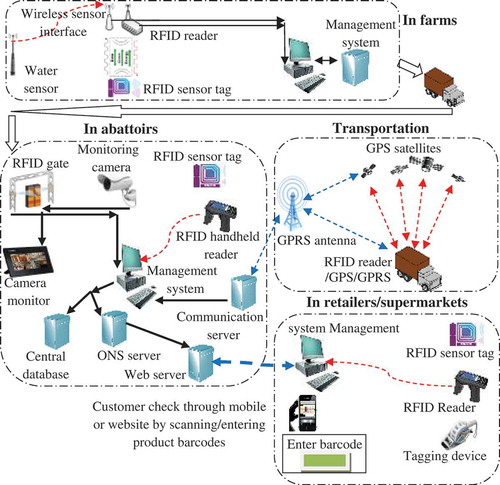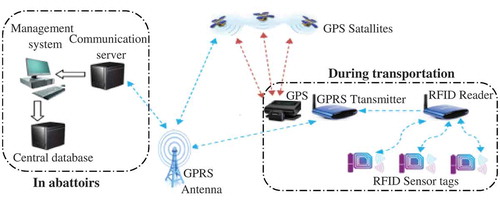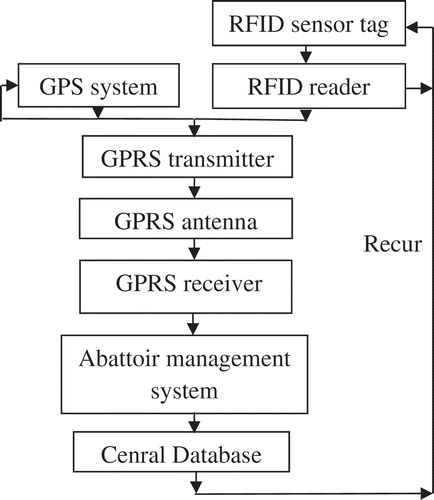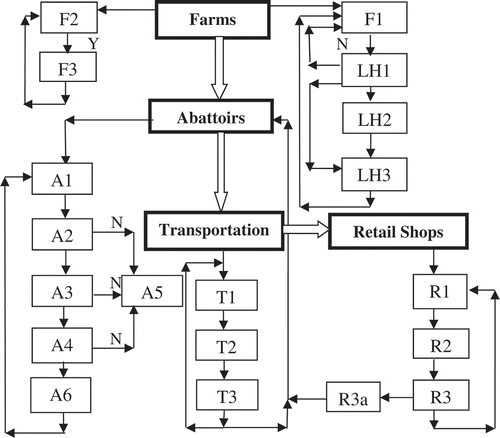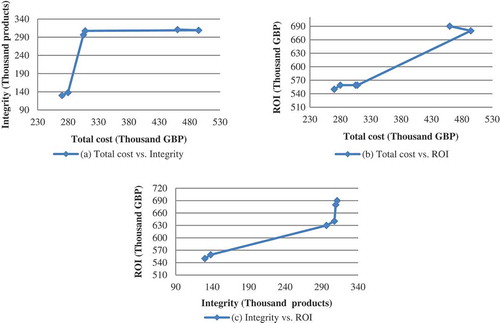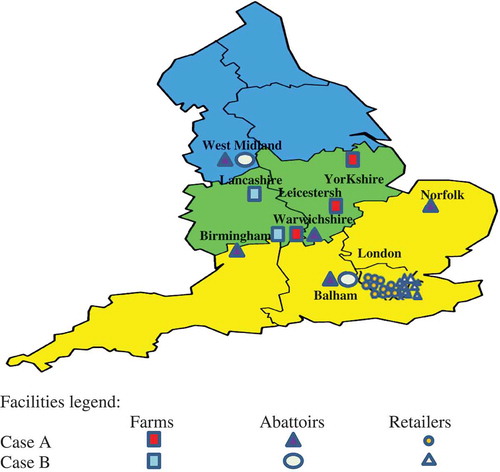ABSTRACT
In recent years, trade of Halal foods is spreading at a rapid pace. Additionally, Halal food consumers have become increasingly concerned about the integrity of Halal-food related products in terms of production, transportation and storage along an entire supply chain network as it is important for Halal food products these consumers purchase from supermarkets are truly Halal. These are unlike traditional principles of any other food type. This requires Halal food suppliers who monitor Halal food supply chains to provide adequate information on foods purchased in supermarkets which can be easily accessed by consumers. This article presents a framework in development of a RFID-enabled monitoring system for a Halal meat supply chain network design for enhancing traceability of integrity of Halal meat products. A multi-objective model was developed for investigating an economic feasibility of the proposed RFID-enabled monitoring system. A case study was used for verifying the effectiveness of the developed mathematical model.
Introduction
Consumption of Halal food is a well-known diet among Muslim and many non-Muslim people; production and supply of Halal meat products is one of the fast-growing businesses in the world. The Islamic term of Halal means “allowed or permitted” in English translation and it is often used in association with food, i.e., food that is permissible under the Islamic Shari’ah (laws) for Muslims to eat or drink. It also specifies a number of criteria that direct people as to how food should be prepared in a Halal way. For instance, production and transportation of Halal meat products need to comply with the Islamic Shari’ah, and this should be applied to all sessions including each process of livestock feeding, slaughtering, transporting, packing, and storing before being sold in supermarkets. In general, the main difference in producing Halal meats from any other type of foods is manifested in ensuring Halal feeding of livestock and monitoring the livestock health at farms in addition to ensuring the Halal slaughtering process at abattoirs. If a specific process of Halal meat supply chains (HMSCs) is not handled properly in a Halal way, retailers or consumers may regard these products as non-Halal. As a result of this, there is a desire for Halal meat consumers who increasingly demand more transparent information relating to integrity of Halal meat products they purchase in supermarkets.[Citation1] Halal integrity means that the product remains Halal from the upstream to downstream supply chain, free from any activities that might breached the Halal status, intentionally or unintentionally.[Citation2]
A survey by authors indicates that there are a number of concerns about integrity of Halal meat products from consumers. These include periodic records in livestock feeding and growing history in farms, slaughtering processes at abattoirs, and Halal meat transportation from abattoirs to retailers. However, these issues are often overlooked by researchers.[Citation2,Citation3]
There are a few preliminary publications in studies on the traceability of Halal meat products. Mansor[Citation4] proposed a method for checking meat colors to determine if the slaughtered poultry is handled properly in the Halal way. Junaini and Abdullah[Citation5] suggested a mobile Halal product verification method on which information of a Halal product can be sent to a customer’s mobile phone using the camera phone barcode scanning technique. Shanahan[Citation6] proposed a radio frequency identification (RFID)-based framework in improving the traceability of cattles at farms and abattoirs where each cattle’s ear is attached with an RFID tag. Kassim[Citation7] synthesized a similar system using mobile applications that allow customers to check Halal product information directly on their mobile phones. Bahrudin[Citation8] developed a tracking system using RFID technology for enhancing Halal product integrity. Feng[Citation9] developed a traceability system by integrating RFID applications into a personal digital assistant (PDA), which is a handheld personal computer (PC) used by operators at beef segmentation sections to collect data and print out information in a form of barcode labels attached with each pack of segmented beef. Similar studies on beef traceability were reported.[Citation10–Citation14]
There were many studies using RFID techniques for improving traceability in ensuring safety and/or originality of food products provided in supply chain sectors. Expósito[Citation15] developed an RFID-based monitoring system used for tracing a wine supply chain. The developed system collects data of the meteorological and botanical information associated with the used grapes from RFID tags that are attached to grape boxes and sends collected data to a central server via a general packet radio service (GPRS) system. These information data can also be accessed online by consumers. Barge[Citation16] describes an item-level traceability system for cheese products in a dairy factory as each piece of cheese is attached with an RFID tag to guarantee a different cheese identification such as cheese type, production date, and expiration date; similar studies were reported.[Citation17–Citation20] In order to identify the origin of agricultural products, Sun[Citation21] developed an anti-counterfeit RFID-global positioning system (GPS) system in which GPS data and encrypted Chinese-sensible codes were applied. The system is used to collect data of location and the weight of the agricultural products and then print the anti-counterfeit label, the collected data is encrypted/decrypted using an advance encrypted standard (AES) algorithm with a different cipher code. Jedermanna[Citation22] developed a smart-container that can also monitor the freshness of fruits during transportation using a combination of RFID sensors, sensor networks, and software agents. Zhang[Citation23] introduced an RFID-based system that can improve traceability of frozen foods in terms of food temperatures and arrival times during storage and transportation using RFID sensors, GPS, and mobile applications. Chen[Citation24] proposed a new type of RFID application namely 2G-RFID-Sys using internet of things (IoT) technology with RFID sensor tags (semi-passive tags integrated with sensors) that can monitor food temperatures in a refined smart cold supply chain. Wang[Citation25] presented a real-time online monitoring decision supporting system which can monitor quality of perishable products providing drivers with suggestions as to how to cope with an abnormality when an alert is triggered during transportation in order to reduce losses of perishable products.
To cope with the increasing demand for the Halal meat products that are produced according to the Islamic Law, a HMSC monitoring system is needed to improve the traceability of Halal meat integrity throughout its entire supply chain. This article presents a framework in development of an RFID-enabled HMSC network for enhancing traceability in terms of integrity of Halal meat products to be sold in supermarkets. Nevertheless, such an integrated system is subject to additional costs for RFID system implementation and return of investment (ROI), which also need to be investigated. To this aim, a multi-objective mathematical model was developed and used for examining the economic feasibility of the proposed RFID-enabled HMSC network in terms of obtaining a trade-off decision making process with three conflicting objectives.
Proposed 2G-RFID-enabled HMSC
illustrates the architecture of a simplified RFID-enabled HMSC for monitoring each process of Halal meat production and transportation. However, the proposed RFID-enabled monitoring HMSC consists of farms, abattoirs, transporters, retailers, and consumers as described below.
In farms, each livestock is attached with a 2G-RFID (second-generation RFID) sensor tag which can store both passive and active information. The 2G-RFID sensor tag is capable of transmitting information data in the relevance to not merely each livestock’s unique identification code but also each livestock’s health status, such as heartbeats and body temperatures. Information data are collected by wireless RFID readers that interrogate RFID-sensor tags by emitting radio signals and subsequently RFID sensor tags respond by sending information data to RFID readers. The gathered information data by RFID readers are sent to a host computer management system afterward. The water supply for each livestock is monitored by a water sensor mounted on a water basin. When contaminated water is detected by a water sensor, it sends an alert to the computer management system and farmers should to isolate those contaminated livestock immediately from others. Periodically, farmers should also take a medical record of livestock relating to illnesses, medical treatments, and treatment results during the growing period. The record should include information of given medical treatments and vaccination that do not contain pork enzymes which make livestock as non-Halal. The growing history of each livestock needs to be input into the computer management system manually. All the collected information data will be analyzed and displayed, as shown in , allowing traders and consumers to check relevant information in terms of integrity of Halal meat products they purchase in farms or supermarkets by either entering product codes online or scan them using their smart mobiles.
Table 1. Growing history of a livestock in farms.
In abattoirs, because each livestock is attached with a 2G-RFID tag, once these transported livestock from farms enter into abattoirs through an RFID-reader mounted gate, information data of each livestock will be collected and stored automatically in an abattoir database. To comply with the Halal slaughtering process,[Citation26] slaughtering places must be monitored by abattoir operators through installed cameras. If a livestock is not slaughtered according to the Hahal way, this livestock needs to be isolated and marked as non-Halal. At the end of the slaughtering process, each segmented meat is packed and tagged with a new 2G-RFID sensor tag that is used for monitoring its pH values and a typical pH value for meats ranges from 4.8 to 5.8.[Citation27] The information data can be collected by an RFID handheld reader and the collected information data are subsequently sent back to the abattoir database.
In transportation, illustrates the architecture of the proposed monitoring system during transportation of Halal meat products from abattoirs to retailers. Each container of a lorry is equipped with an RFID reader, a temperature sensor, a GPS, and a GPRS system. The RFID reader is used for collecting identification information as well as pH values from 2G-RFID sensor tags, which are attached with each of packed Halal meat products in the lorry. The GPS is used for tracking locations of the lorry sporadically providing an estimated arrival time to retailers. A temperature sensor continuously detects container temperatures and sends an alert to notify drivers if the temperature reaches the upper limit. Information data collected by an RFID reader and a GPS are sent back to the abattoir management system over a GPRS network that consist a GPRS transmitter, an antenna, and a receiver. These data can be retrieved by retailers. GPRS rather than GSM (global system for mobile) was selected as its active transmission can share available resources. Also, it uses a packet switch technique allowing an allocation of resources when needed; furthermore, it provides a data transfer rate up to 172 kbps. shows data transmission flow throughout the transportation monitoring process.
In retailers or supermarkets, once packed meats from abattoirs arrive at a retailer or a supermarket, each packed meat is scanned by a handheld RFID reader to collect information data that are subsequently uploaded into an inventory management system at the retailer or the supermarket. Meat in each package may then be sliced and repacked in smaller sizes and each re-packed meat is tagged with a barcode label that contains relevant information of the packed meat product as shown in , which can be accessed by consumers entering barcodes online or using a mobile scanner.
Table 2. Information of a packed meat product at abattoirs to be sold at retailers or supermarkets.
shows a flowchart that illustrates a complete monitoring process during Halal meat production (at farms and abattoirs), transportation, and in retailers. shows the corresponding operations (or actions) that may be taken into account in order to maintain Halal meat integrity throughout the proposed HMSC network.
Table 3. The corresponding operations or actions of a HMSC monitoring process shown in .
Multi-objective mathematical model
There are a number of similar studies in optimization of supply chains design using multi-objective approaches. Amin and Zhang[Citation28] created a mixed integer linear programming model aiming to minimize the total cost for multiple locations in a closed-loop supply chain network. Kannan[Citation29] developed a genetic algorithm method for seeking a solution in minimization of total costs for a closed-loop supply chain. Lee and Dong[Citation30] presented a stochastic model for managing a supply chain with three objectives including costs of facility location, path selection, and transportation. Pishvaee and Razmi[Citation31] established a multi-objective fuzzy model for optimizing a green supply chain design in minimizing total costs as well as environmental impact.
A mathematical model with three conflicting objectives was developed for investigating the economic feasibility of the proposed RFID-enabled HMSC in order to obtain a cost-effective decision. The first objective (Z1) is aimed at minimizing the total investment cost. The second objective (Z2) is aimed at maximizing the Halal meat integrity in terms of the number for Halal meat products. And the third objective (Z3) is aimed at maximizing ROI. Sets, parameters, and variables are described as follows:
Sets:
| I | = | set of farms |
| = | set of abattoirs | |
| = | set of retailers |
Parameters:
| = | RFID equipment (E) cost (GBP) required for farm | |
| = | RFID equipment (E) cost (GBP) required for abattoir | |
| = | RFID implementation (I) cost (GBP) required for farm | |
| = | RFID implementation (I) cost (GBP) required for abattoir | |
| = | unit transportation (T) cost (GBP) per mile from farm | |
| = | unit transportation (T) cost (GBP) per mile from abattoir | |
| = | travel distance (mile) from farm | |
| = | travel distance (mile) from abattoir | |
| = | transportation capacity (units) per vehicle | |
| = | maximum supply capacity (units) of farm | |
| = | maximum supply capacity (units) of abattoir | |
| = | minimum demand (in units) of abattoir | |
| = | minimum demand (in units) of retailer | |
| = | integrity percentage through first transportation link u from farm | |
| = | integrity percentage through second transportation link v from abattoir | |
| = | ROI (GBP) per item for farm | |
| = | ROI (GBP) per item for abattoir | |
| Variables: | = | |
| = | quantity of units transported through the first transportation link u from farm | |
| = | quantity of units transported through the second transportation link v from abattoir | |
| = | 1: if farm | |
| = |
| |
| = | 1: if abattoir | |
| = |
|
To minimize the total investment cost Z1, which consists of equipment costs, implementation costs, and transportation costs, it is given by:
To maximize integrity of Halal meat products, Z2, is the main objective of the RFID-based monitoring HMSC network, it is given by:
ROI, Z3, is one of three objectives that need to be considered. To maximize ROI, it is given by:
Subject to
where constraints 4–5 are supply constraints in quantity and constraints 6–8 are demand constraints in quantity.
Solution methodology
Optimization approach
In order to obtain Pareto optimal solution, a solution approach was developed. This approach transforms the multi-objective model into a single-objective model (Zs) which is formulated by considering each objective individually. This single-objective model aims to minimize the scalarized differences between each objective and its optimal value. Undesired deviations (Zd) are proposed to be subtracted from Zs with the aim to achieve more accurate objective values. These values are close enough to non-inferior optimal solutions which lead to a clear insight of a compromise solution between conflicting objectives for decision makers. The solution approach function (Z) can be formulated as follows:
where
Finally, based on the previously mentioned procedures, the solution objective function can be written as follows.
The constraints contain Eqs. (4–10) and Eq. (15). Utilizing this approach yields a mono objective function, mixed integer linear programming model which can be solved using a linear programming solver, for example, LINGO or Xpress.
Decision making algorithm
Once the Pareto optimal solution are obtained, it needs to determine one optimal solution used for implementation. The selected solution is associated with the highest degree of preference for the all related objectives to decision makers. So far, several approaches have been employed aiming to select the best trade-off in multiple objectives problem. In this article, a new decision making algorithm was developed and used to select the best solution from the derived Pareto set. The selected solution should has the highest superiority value S which is determined by a summation of the minimum distance to the ideal solution Z+ and the maximum distance to the worse solution Z−. The selection formula can be expressed as follows:
Application and evaluation
In order to examine the applicability of the developed mathematical model as well as the usefulness of the developed solution methodology, two case studies were applied based on data shown in . The data were collected from farms, abattoirs, and retailers by the Halal Meat Committee in the United Kingdom.[Citation32] Travel distances were estimated between farms and abattoirs and between abattoirs and retailers using the Google map. In case study A, the London—South West area was considered, it includes five farms, six abattoirs, and 11 retailers. In case study B, the London—South East area was considered. It includes five farms, six abattoirs, and three retailers.
Table 4. Collected data from the HMC.
In this work, LINGO[Citation11] was used for computing results aiming to seek optimization solutions. shows outputs of Pareto solutions which were obtained by assigning varying weight values to each objective for case study A and B, respectively. These solutions are associated with allocations of farms, abattoirs, and retailers that need to be opened for a specified supply chain network. These results, however, were obtained by assigning seven sets of three varying weight values to the three objectives.
Table 5. Computational results for cases A and B, respectively.
By analyzing the obtained solutions, the objective functions (by minimize the total investment cost, maximize the Halal meat integrity, and maximize ROI) are conflicting, i.e., maximizing or minimizing one objective value may lead to an increase of undesired values of other one or two objectives. As an example, a maximal integrity number of Halal meat products and a maximal ROI may result in an increase of the undesired value which is total investment cost. A pairwise comparison among the three conflicting objectives for case A is illustrated in . Based on the illustrated confliction, the result shown in indicates that decision makers do not need to invest more than 305,076 GBP on the RFID-based monitoring HMSC network as it will slightly increase the number of Halal meat products. By comparison, the computed result shown in indicates that decision makers need not to invest more than 459,858 GBP to achieve a maximal ROI of 690,260 GBP, i.e., a further increase in terms of the total investment cost from 459,858 to 494,596 GBP will not lead to an increase but a slight decrease of ROI which proves that the maximum total investment cost does not necessarily lead to a maximal ROI. The result shown in indicates a maximal number of Halal meat products (311,230 items) that yields a maximal ROI of 690,260 GBP.
In practice, one of these solutions must be selected by preferences of decision makers or using a decision making algorithm. To this aim, the developed decision making algorithm was utilized. Accordingly, solution 3 is the best solution for case A and solution 2 is the best solution for case B. It is noted that solution three for case study A generates a maximal ROI of 559,000 GBP, a maximal integrity number of 137,952 items and a minimal total investment cost of 279,922 GBP, it gives three farms and five abattoirs that need to be opened for the specified HMSC network. The result for solution two for case study B gives a maximal ROI of 210,000 GBP, a maximal integrity number of 93,151 items and a minimal total investment cost of 90,480 GBP, which suggests two farms and two abattoirs that need to be opened for the specified HMSC network.
Finally, shows the selected optimal design of HMSC networks that were obtained by setting up weight values (0.8, 0.1, 0.1) for case study A (solution three in ) and (0.9, 0.05, 0.05) for case study B (solution two in ). The geographic configuration shows locations of farms, abattoirs, and retailers which need to be established for the proposed RFID-based HMSC network design. For instance, solution three for case study A suggests that the HMSC network needs three farms located in Warwickshire, Leicestershire, and Yorkshire, respectively, and five abattoirs located in Birmingham, Balham, West Midland, Warrick, and Norfolk, respectively. These abattoirs supply Halal meat products to eleven retailers. Solution two for case study B suggests the HMSC network needs two farms located in Lancashire and Warwickshire, respectively, and two abattoirs located in Balham and West Midland, respectively. These abattoirs supply Halal meat products to three retailers.
Conclusions
A study by Wang,[Citation33] suggested that RFID implementation is a trend for future generation automated warehouses in logistics and supply chain sectors. This article presents a feasibility study by examining a proposed RFID-based monitoring process that enhances integrity of HMSCs using the multi-objective approach. This includes a framework of an RFID-based monitoring system that collects relatively accurate and real-time information data in order to improve traceability of Halal meat products in each process at production and transportation sectors. Retailers and consumers can also check meat product information that relates to Halal meat integrity online or using mobile phones. A multi-objective mathematical model was developed as an aid for a trade-off decision making process in design of the proposed RFID-enabled HMSC network. Subsequently, a solution methodology was developed including a solution approach to obtain Pareto solutions and a decision making algorithm to select the best Pareto solution. Based on the computed results, the proposed system is economically feasible as a relatively high profit can be possibly obtained.
The developed mathematical model has considered different parameters such as integrity percentages and demands which are subject to uncertainty. Thus, this article can be extended to address the uncertainty in these parameters using a stochastic programming model; however, this concern is significant regarding the HMSC network design.
References
- Bosona, T.; Gebresenbet, G. Food Traceability as an Integral Part of Logistics Management in Food and Agricultural Supply Chain. Food Control 2013, 33(1), 32–48.
- Zulfakar, M.H.; Jie, F.; Chan, C. Halal Food Supply Chain Integrity: From a Literature Review to a Conceptual Framework. RMIT University Paper, 2012; 1–23.
- Lodhi, A. Understanding Halal Food Supply Chain, 1st Ed; HFRC UK Ltd.: London, 2009.
- Mansor, M.A.; Shah Baki, S.-R.M.; Tahir, N.M.; Rahman, R.A. An Approach of Halal Poultry Meat Comparison Based on Mean-Shift Segmentation. IEEE Conference on Systems, Process and Control (ICSPC2013), Kuala Lumpur, Malaysia, 13–15 December 2013; pp. 279–282
- Junaini, S.N.; Abdullah, S. MyMobiHalal 2.0: Malaysian Mobile Halal Product Verification using Camera Phone Barcode Scanning and MMS. International Conference on Computer and Communication Engineering, Kuala Lumpur, Malasyia, 10-12 June 2008; pp. 528–532.
- Shanahan, C.; Kernan, B.; Ayalew, G.; McDonnell, K.; Butler, F.; Ward, S. A Framework for Beef Traceability Fromfarmto Slaughter Using Global Standards: An Irish Perspective. Computers and Electronics in Agriculture 2009, 66(1), 62–69.
- Kassim, M.; Haroswati, C.; Yahayal, C.H.; Hafiz, M.; Zaharuddin, M. A Prototype of Halal Product Recognition System. International Conference on Computer & Information Science (ICCIS). Kuala Lumpur, Malaysia, 12-14 June 2012; 990–994 pp.
- Bahrudin, S.M.M.; Illyas, M.I.; Desa, M.I. Tracking and Tracing Technology for Halal Product Integrity over the Supply Chain. International Conference on Electrical Engineering and Informatics, Bandung, Indonesia, 11-13 July 2011; H1–2.
- Feng, J.; Fu, Z.; Wang, Z.; Xu, M.; Zhang, X. Development and Evaluation on a RFID-Based Traceability System for Cattle/Beef Quality Safety in China. Food Control 2013, 31(2), 314–325.
- Bowling, M.B.; Pendell, D.L.; Morris, D.L.; Yoon, Y.; Katoh, K.; Belk, K.E. Review: Identification and Traceability of Cattle in Selected Countries Outside of North America. The Professional Animal Scientist 2008, 24, 287–294.
- Kang, R.J.; Zhang, X.S.; Fu, Z.T.; Mu, W.S. Method of Traceability Information Acquisition and Transmission for Beef Cattle Sector Based on PDA and FSM. Nongye Gongcheng Xuebao/Transactions of the Chinese Society of Agricultural Engineering 2010, 26(1), 227–231.
- Shi, L.; Fu, Z.T.; Zhang, L.X. An RFID-Based Traceability System for Quality Insurance of Beef Cattle Breeding. Computer Applications and Software 2010, 27(1), 40–43.
- Lu, G.M.; Zhang, X.S.; Mu, W.S.; Fu, Z.T.; Zhang, J. Method of Quality Traceability Data Acquisition and Transmission for Beef Processing. Computer Engineering and Design 2009, 30(15), 3657–3659.
- Lu, G.M.; Zhang, X.S.; Mu, W.S.; Fu, Z.T.; Zhang, J. Implementation of Traceability System for Beef Processing Based on Web Multilayer Structure. Computer Applications and Software 2010, 27(1), 20–22.
- Expósito, I.; Gay-Fernández, J.A.; Cuiñas, I. A Complete Traceability System for a Wine Supply Chain Using Radio-Frequency Identification and Wireless Sensor Networks. IEEE Antennas and Propagation Magazine 2013, 55(2), 255–267.
- Barge, P.; Gay, P.; Merlino, V.; Tortia, C. Item-Level Radio-Frequency Identification for the Traceability of Food Products: Application on a Dairy Product. Journal of Food Engineering 2014, 125, 119–130.
- Hsu, C.I.; Liu, K.P. A Model for Facilities Planning for Multi-Temperature Joint Distribution System. Food Control 2011, 22(12), 1873–1882.
- Hsu, Y.-C.; Chen, A.-P.; Wang, C.-H. A RFID-Enabled Traceability System for the Supply Chain of Live Fish. IEEE International Conference on Automation and Logistics. Qingdao, China, 1-3 September 2008; 81–86 pp.
- Abada, E.; Palaciob, P.; Nuinc, N.; González de Záratec, A.; Juarrosa, A.; Gómezb, J.M.; Marco, S. RFID Smart Tag for Traceability and Cold Chain Monitoring of Foods: Demonstration in an Intercontinental Fresh Fish Logistic Chain. Journal of Food Engineering 2009, 93(4), 394–399.
- Trebar, M.; Grah, A.; Melcon, A.A.; Parreno, A. Towards RFID Traceability Systems of Farmed Fish Supply Chain. Software, Telecommunications and Computer Networks (SoftCOM), 2011; 1–6 pp.
- Sun, C.; Li, W.-Y.; Zhou, C.; Li, M.; Yang, X.-T. Anti-Counterfeit System for Agricultural Product Origin Labeling Based on GPS Data and Encrypted Chinese-Sensible Code. Computers and Electronics in Agriculture 2013, 92, 82–91.
- Jedermanna, R.; Behrensb, C.; Westphalb, D.; Langa, W. Applying Autonomous Sensor Systems in Logistics—Combining Sensor Networks, RFIDs and Software Agents. Sensors and Actuators A: Physical 2006, 123(1), 370–375.
- Zhang, J.; Liu, L.; Mu, M.; Moga, L.M.; Zhang, X. Development of Temperature-Managed Traceability System for Frozen and Chilled Food During Storage and Transportation. Food, Agriculture and Environment 2009, 7(3&4), 28–31.
- Chen, Y.-Y.; Wang, Y.-J.; Jan, J.-K. A Novel Deployment of Smart Cold Chain System Using 2G-RFID-Sys. Journal of Food Engineering 2014, 141, 113–121.
- Wang, L.; Kwok, S.K.; Ip, W.H. A Radio Frequency Identification and Sensor-Based System for the Transportation of Food. Journal of Food Engineering 2010, 101(1), 120–129.
- Academy, Islamic Fiqh, July 1999. http://ar.islamway.net/fatwa/28033/ ( accessed October 26, 2014).
- Lomiwe, D.; Farouk, M.; Frost, D.A.; Dobie, P.M.; Young, Q.A. The biochemical basis in trendiness in beef. A PhD project, Hamilton, New England: Food & Bio-based Product Group, 2010; n.d.
- Amin, S.; Zhang, G. A Multi-Objective Facility Location Model for Closed-Loop Supply Chain Network Under Uncertain Demand and Return. Applied Mathematical Modelling 2013, 37(6), 4165–4176.
- Kannan, G.; Sasikumar, P.; Devika, K. A Genetic Algorithm Approach for Solving a Closed Loop Supply Chain Model: A Case of Battery Recycling. Applied Mathematical Modelling 2010, 34(3), 655–670.
- Lee, D.; Dong, M. Dynamic Network Design for Reverse Logistics Operations Under Uncertainty. Transport. Research Part E: Logistics and Transportation Review 2009, 451(1), 61–71.
- Pishvaee, M.S.; Razmi, J. Environmental supply Chain Network Design Using Multi-Objective Fuzzy Mathematical Programming. Applied Mathematical Modelling 2012, 36(8), 3433–3446.
- HMC, (UK), 2016, http://www.halalhmc.org/, http://www.halalhmc.org/test-demo.htm (accessed October 26, 2014).
- Wang, Q.; McIntosh, R.; Brain, B. A new-generation automated warehousing capability. International Journal of Computer Integrated Manufacturing 2010, 23(6), 565–573.

